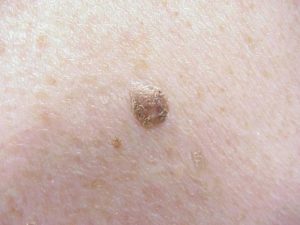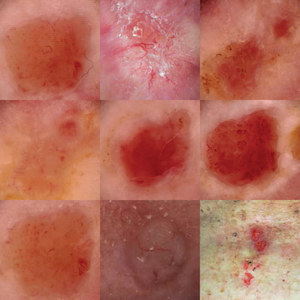 Squamous Cell Carcinoma
Squamous Cell Carcinoma
Squamous cell carcinoma (SCC) is a cutaneous skin cancer arising from malignant proliferation of epidermal keratinocytes. Squamous cell carcinoma is the second most common skin cancer after basal cell carcinoma (BCC). Incidence of SCC have increased over the past 20 years probably due to high levels of sun exposure, tanning bed use, aging and early detection.
READ MORE
Seborrhoeic Keratosis
Seborrhoeic keratosis is a benign (non-cancerous) proliferation of squamous epidermal cells that is wart like on the skin. They are very commonly seen in elderly patients. They can have very similar morphology as other skin lesion that should be ruled out.
READ MORE
Moles (naevi)
Melanocytic naevi (moles) are common neoplasms that result from the proliferation of cutaneous melanocytes that grow in clusters on clumps. Melanocytic naevi (Moles) are benign proliferations of a type of melanocyte known as a “naevus cell.” However they can sometimes become malignant and require close monitoring.
READ MORE
 Ephiledes (Freckles)
Ephiledes (Freckles)
Freckles are small, tan to brown macule that can turn dark when exposed to sunlight.
Histopathologically, these lesions demonstrate increased epidermal melanin without increasing in melanocytes.
READ MORE
 Lentigo
Lentigo
Lentigo are benign pigmented macules that result from increased activity of epidermal melanocytes. Lentigo like lesion can be benign or malignant, it is therefore important to rule out malignant lesions.
READ MORE
 Dermatofibroma
Dermatofibroma
Dermatofibromas are benign tumors of fibroblast and histiocytic origins in the dermis, often referred to as benign fibrous histiocytomas that can happen after trauma
READ MORE
Large Cell Acanthoma
Large cell acanthoma (LCA) also called Degos acanthoma is a benign tumor of the sebaceous gland that can often be confused with seborrhoeic keratosis or melanoma.
READ MORE
 Lichenoid keratosis
Lichenoid keratosis
Lichenoid keratosis is also known as Lichen planus-like Keratosis (LPLK) that present as small, solitary (90% of cases), brown macule or papule that can turn red and itchy . There is often an inflammatory component to it. Lichenoid keratosis are generally seen in fair-skinned patients aged 30 to 80 years old with a predilection for women than men.
READ MORE
 Actinic Keratosis (Solar Keratosis)
Actinic Keratosis (Solar Keratosis)
Actinic keratosis (AK) is also known as solar keratosis. This is a premalignant lesion that results from the proliferation of atypical epidermal keratinocytes.
READ MORE
 Angioma
Angioma
Angiomas are tumor of the blood vessels. The 2 angiomas that are commonly seen include: Strawberry angioma (infantile) and Cherry Angioma (senile angioma).
READ MORE
 Melanoma
Melanoma
 Basal Cell Carcinoma
Basal Cell Carcinoma Squamous Cell Carcinoma
Squamous Cell Carcinoma

 Ephiledes (Freckles)
Ephiledes (Freckles) Lentigo
Lentigo Dermatofibroma
Dermatofibroma Lichenoid keratosis
Lichenoid keratosis Actinic Keratosis (Solar Keratosis)
Actinic Keratosis (Solar Keratosis) Angioma
Angioma